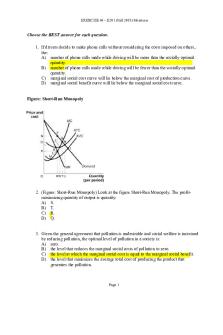Homework 4 - Questions and answers PDF

| Title | Homework 4 - Questions and answers |
|---|---|
| Course | Numerical Methods and Programming for Chemical Engineers |
| Institution | Louisiana State University |
| Pages | 10 |
| File Size | 465.2 KB |
| File Type | |
| Total Downloads | 62 |
| Total Views | 142 |
Summary
Questions and answers...
Description
Assignment 4 function hw4lorenz clc %Number 1 - Lorenz Model %Lorenz Model is used for modeling convection problems %Part (i) for (a,b,c)=(5,12,2) a=5; b=12; c=2; [t,y]=ode45(@lorenz,[0:.05:25],[1 0 0],1e-5); figure subplot(2,1,1) plot(t,y(:,2)) %Time series plot title('Time Series Plot') xlabel('Time') ylabel('y(1)')
subplot(2,1,2) plot(y(:,1),y(:,2)) title('Projection of the Phase Space') xlabel('y(1)') ylabel('y(2)')
%Long term nature of the solution response is constant (straight line) %around 5
%Part (ii) for (a,b,c)=(3,220,1) a=3; b=220; c=1; [t2,y2]=ode45(@lorenz,[0:.05:25],[1 0 0],1.e-5);
figure subplot(2,1,1) plot(t2,y2(:,2),'r') %Time series plot title('Time Series Plot') xlabel('Time') ylabel('y(1)')
subplot(2,1,2) plot(y2(:,1),y2(:,2),'r') title('Projection of the Phase Space') xlabel('y(1)') ylabel('y(2)')
%Long term nature of the solution response fluctuates between -100 and 100
%Part (iii) for (a,b,c)=(5,17,1) a=5; b=17; c=1; [t3,y3]=ode45(@lorenz,[0:.05:100],[1 0 0],1.e-5);
figure subplot(2,1,1) plot(t3,y3(:,2),'r') %Time series plot title('Time Series Plot') xlabel('Time') ylabel('y(1)')
subplot(2,1,2) plot(y3(:,1),y3(:,2),'r') title('Projection of the Phase Space') xlabel('y(1)') ylabel('y(2)') %Long term nature of the solution response fluctuates between -15 and 15
function f=lorenz(t,y) %Calculates t and y f(1)=-a*y(1)+a*y(2); f(2)=b*y(1)-y(2)-y(3)*y(1); f(3)=-c*y(3)+y(1)*y(2); f=f'; end
end
Published with MATLAB® R2014a
function hw4bratu %Number 2 - Bratu's equation for combustion modeling problems %Part a eps=0.1; figure subplot(2,1,1); for i=1:5 %Run 5 times to cover epsilon=0.1-0.5 mu=5; solinit=bvpinit([-1:.1:1],[1 0]); %x guess/y guess sol=bvp4c(@bratu,@bc,solinit) hold on plot(sol.x,sol.y(1,:)) %Mesh selected by bvp4c and approx y(x) title('Bratu Equation, part a') xlabel('x') ylabel('u(x)') eps=eps+0.1; end
sol =
solver: 'bvp4c' x: [1x21 double] y: [2x21 double] yp: [2x21 double] stats: [1x1 struct]
sol =
solver: 'bvp4c' x: [1x21 double] y: [2x21 double] yp: [2x21 double] stats: [1x1 struct]
sol =
solver: 'bvp4c' x: [1x21 double] y: [2x21 double] yp: [2x21 double] stats: [1x1 struct]
sol =
solver: 'bvp4c' x: [1x21 double] y: [2x21 double] yp: [2x21 double] stats: [1x1 struct]
sol =
solver: 'bvp4c' x: [1x21 double] y: [2x21 double] yp: [2x21 double] stats: [1x1 struct]
%Part B eps=0.1; %Resetting epsilon for part b
subplot(2,1,2); for i=1:6 mu=0; solinit2=bvpinit([-1:.1:1],[1 0]); %x guess/y guess sol2=bvp4c(@bratu,@bc,solinit2) hold on plot(sol2.x,sol2.y(1,:)) %Mesh selected by bvp4c and approx y(x) title('Bratu Equation, part b') xlabel('x') ylabel('u(x)') eps=eps+0.1; end
sol2 =
solver: 'bvp4c' x: [1x21 double] y: [2x21 double] yp: [2x21 double] stats: [1x1 struct]
sol2 =
solver: 'bvp4c' x: [1x21 double] y: [2x21 double] yp: [2x21 double] stats: [1x1 struct]
sol2 =
solver: 'bvp4c' x: [1x21 double] y: [2x21 double] yp: [2x21 double] stats: [1x1 struct]
sol2 =
solver: 'bvp4c' x: [1x21 double]
y: [2x21 double] yp: [2x21 double] stats: [1x1 struct]
sol2 =
solver: 'bvp4c' x: [1x21 double] y: [2x21 double] yp: [2x21 double] stats: [1x1 struct]
sol2 = solver: 'bvp4c' x: [1x21 double] y: [2x21 double] yp: [2x21 double] stats: [1x1 struct]
%Part C eps=3;mu=0; solinit3=bvpinit([-1:.1:1],[-3 3]); %x guess/y guess sol3=bvp4c(@bratu,@bc,solinit3) figure plot(sol3.x,sol3.y(1,:)) title('Bratu Equation, part c') xlabel('x') ylabel('u(x)')
Warning: Unable to meet the tolerance without using more than 5000 mesh points. The last mesh of 2725 points and the solution are available in the output argument. The maximum residual is 0.0591363, while requested accuracy is 0.001.
sol3 =
x: [1x2725 double] y: [2x2725 double] yp: [2x2725 double] solver: 'bvp4c'
%Functions function f=bratu(x,y) f(1)=y(2); f(2)=-eps*exp(y(1)/(1+mu*y(1))); end
function b=bc(lb,rb) %left boundary, right boundary b=[lb(1); rb(1)]; end end
Published with MATLAB® R2014a...
Similar Free PDFs

Homework 4 - Questions and answers
- 10 Pages

Homework 1-4 Questions AND Answers
- 36 Pages

4 2016, questions and answers
- 142 Pages

Module 4 Questions and Answers
- 6 Pages

Exercise 4 Questions and Answers
- 8 Pages

Quiz 4 Questions and Answers
- 3 Pages

Ch 4 questions and answers
- 5 Pages
Popular Institutions
- Tinajero National High School - Annex
- Politeknik Caltex Riau
- Yokohama City University
- SGT University
- University of Al-Qadisiyah
- Divine Word College of Vigan
- Techniek College Rotterdam
- Universidade de Santiago
- Universiti Teknologi MARA Cawangan Johor Kampus Pasir Gudang
- Poltekkes Kemenkes Yogyakarta
- Baguio City National High School
- Colegio san marcos
- preparatoria uno
- Centro de Bachillerato Tecnológico Industrial y de Servicios No. 107
- Dalian Maritime University
- Quang Trung Secondary School
- Colegio Tecnológico en Informática
- Corporación Regional de Educación Superior
- Grupo CEDVA
- Dar Al Uloom University
- Centro de Estudios Preuniversitarios de la Universidad Nacional de Ingeniería
- 上智大学
- Aakash International School, Nuna Majara
- San Felipe Neri Catholic School
- Kang Chiao International School - New Taipei City
- Misamis Occidental National High School
- Institución Educativa Escuela Normal Juan Ladrilleros
- Kolehiyo ng Pantukan
- Batanes State College
- Instituto Continental
- Sekolah Menengah Kejuruan Kesehatan Kaltara (Tarakan)
- Colegio de La Inmaculada Concepcion - Cebu








